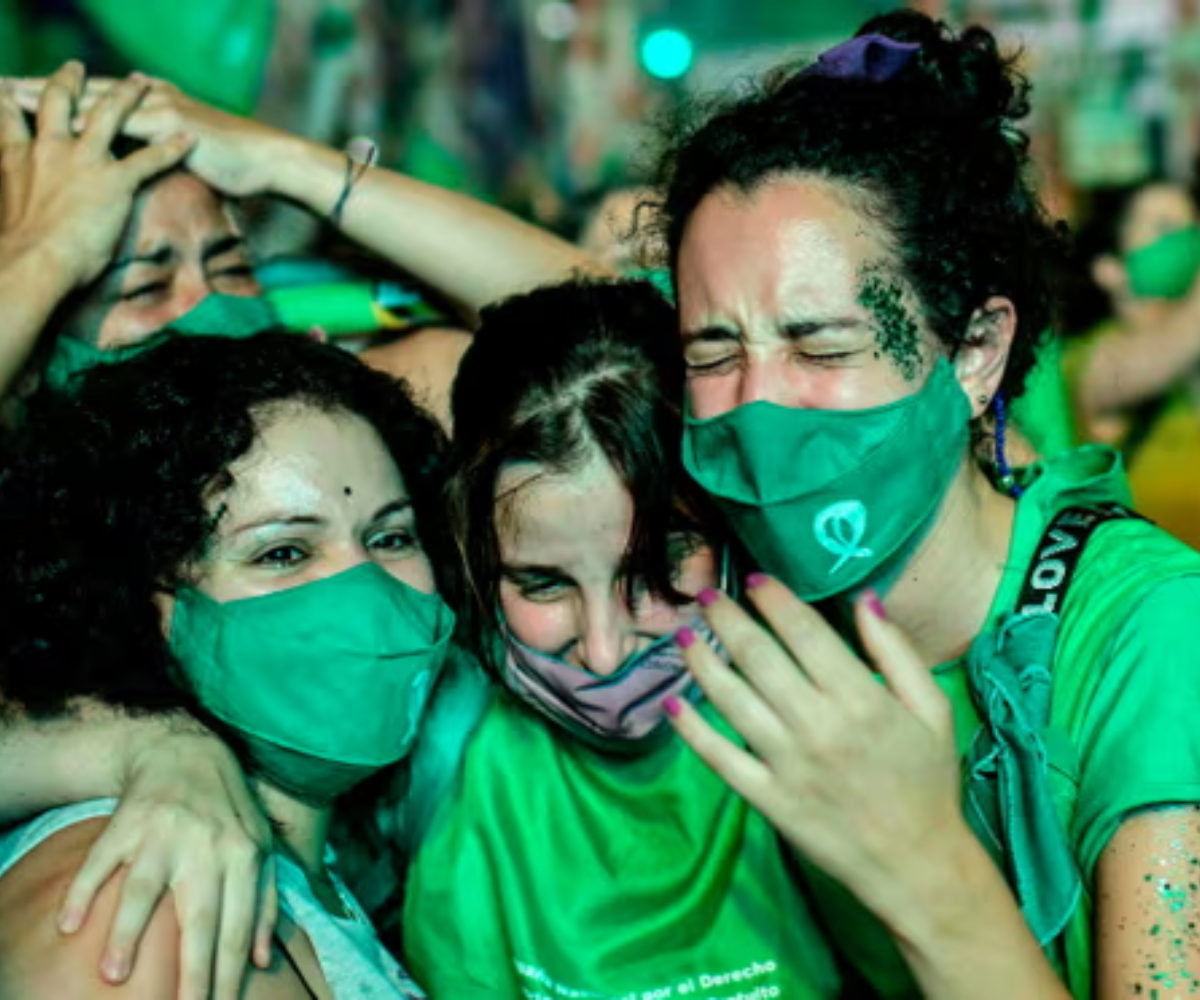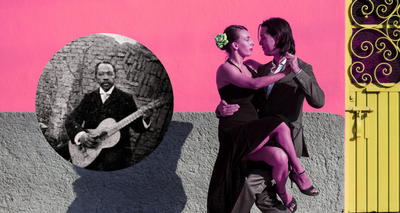Abortion has been around for centuries, whether people want to admit it or not. However, as we well know, the stance on this controversial subject fluctuates between countries and states —Even households can’t find a common ground. What this means is that women’s rights are at risk no matter how safe we believe they are. Just look at Roe v. Wade overturned by the U.S. Supreme Court in 2022, making abortion no longer a constitutionally established right. As a result, U.S. Latinas across the states and other marginalized women are facing much steeper issues with access and affordable reproductive care. For decades, women globally have been fighting for reproductive rights including Latin American feminists who put the symbol of a ‘green scarf’ on the map for all to eagerly adopt.
However, The Associated Press-NORC Center for Public Affairs Research has shown an increase of support for abortion access since the overturning of Roe v. Wade, and more than a half of American adults claimed that women should be allowed the access to safe abortion no matter the reason. Thankfully, the electorate’s opinions have been heard and, with Kamala Harris as their leader, the Democratic National Committee announced an investment of “at least $8.3 million across every state party in the country this year,” according to CBS News.
The pro-choice movement continues with its massive demonstrations across the country, and its supporters have taken to the streets wearing a particular item of clothing: green scarf. But where does this green scarf —known as pañuelo verde in Spanish— come from? What’s the story behind it? How and why did it become the symbol of the fight for abortion rights?
The Movement Started In South America
A “green tide”. This is how some media described the feminist movement that developed in Argentina in the second half of the 2010s. Looking at the picture below, we can see why the movement earned this nickname. The firsts to wear this scarf as a symbol of the fight for pro-choice rights were the Argentinian feminists.
In 2005, a civil society was born: the National Campaign for the Right to Legal, Safe and Free Abortion (Campaña Nacional por el Derecho al Aborto Legal, Seguro y Gratuito). This movement adopted the green scarf as its emblem, accompanied by the slogan “Sexual education to decide, contraception not to abort, legal abortion not to die.”
In 2018, la Campaña presented for the 7th time a bill to legalize abortion in Argentina and, for the first time, it was debated in Congress. From that year on, it became more and more common to see women of all ages wearing the campaign scarf. They carried them around their necks, hanging on the straps of their backpacks and purses, or tied to their fanny packs. Even pet dogs wore them as collars. On the TV sets, Argentine celebrities wore them tied around their wrists to show their support for the pro-choice bill. At the 2018 edition of the Martín Fierro Awards, the most prominent awards for Argentine television, celebrities wore green dresses, scarfs, bows and other accessories to show their support for the abortion movement.
Unfortunately, 2018 was not the year of the decriminalization of abortion in Argentina. The bill was voted in favor by the Chamber of Deputies, but it was rejected in by the Senate, which was considerably more conservative. However, this helped install the debate massively in the political agenda and in the media; and two years later, in December 2020, Argentina’s Senate approved the bill to legalize abortion, with 38 senators in favor and 29 against.
What happened next? Recent polls showed that maternal deaths due to abortion decreased between 2020 and 2021, and there was also a decrease in the adolescent fertility rate. However, the distribution by provinces of the number of legal abortions was unequal, proof that there is still much work to be done to guarantee this fundamental right.
Historical Roots of the Green Scarf
Although 2018 was when pro-choice activists adopted the green scarf as an emblem of their fight, this symbol had existed for a long time. Every year, since 1983, Latin American women of Argentina hold the National Women’s Meeting (Encuentro Nacional de Mujeres); a national event in which thousands of women participate in feminist workshops, debates and other activities.
In the 2003 edition, the head of the Argentine branch of Pro-Choice Catholic Women (Catolicas por el Derecho a Decidir; a regional network with a religious and feminist perspective), Marta Alanis, suggested using it as an emblem of the meeting because it is “a symbol of hope, health and life”. It’s estimated that that year, 2003, the production of green scarfs reached around 8,000 units; in 2018, the figure amounted to 200,000.
The Influence of the White Scarves of Plaza de Mayo
However, all this doesn’t fully explain why it was chosen to use a scarf as a symbol of the fight. In Argentina, these triangular scarves are full of symbolism. That is due to the Mothers and Grandmothers of Plaza de Mayo, brave women who wore white scarfs on their heads (these were their missing children’s diapers). Mothers and Grandmothers are two women’s organizations that have been fighting to find their missing children and grandchildren, kidnapped by the Argentine military dictatorship between 1976 and 1983, for decades. In recent years, leaders and members of both groups have also expressed their support for the decriminalization of abortion.
La Asociación Madres de Plaza de Mayo filial Mar del Plata repudian y se solidarizan con la mujer agredida por llevar un pañuelo verde a favor del aborto legal, seguro y gratuito. pic.twitter.com/CcORyH3k0j
— Asociación Madres de Plaza de Mayo Mar del Plata (@MadresPlaza) January 27, 2021
The Green Scarf Spreads Across Latin America
Around the time of the #MeToo momentum, the world discovered the Argentine “green tide”. The feminist cry of the South American country had a contagious effect, and soon other countries in the region “turned green”. In Ecuador, after a heated debate, the National Assembly recognised the right to have an abortion in cases of rape within certain time windows.
In Chile, where abortion had been criminalized since the dictatorship of Augusto Pinochet, they managed to decriminalize abortion for three specific cases: when the mother’s life is in danger, in cases of rape, and in case of non-viable pregnancies.
In September 2021, Mexico declared unconstitutional the criminalization of abortion. In addition, there were a series of landmark rulings that established a precedent and paved the way for a future legalization. Then, on September 6, 2023, abortion was decriminalized nationwide.
To date, the only Latin American countries where abortion is legal, safe and free on request are Argentina, Mexico, Colombia, Uruguay, Cuba and Guyana.
Abortion Rights in the United States: A Contrast
All this progress in Latin America contrasts sharply with what is happening in the United States, where there’s a wave of restrictions on women’s sexual and reproductive rights. But what exactly is going on in the U.S.? To understand it, we need to go back in time a little, specifically to 1973, when Roe v. Wade was handed down.
Roe v. Wade was a court case in which the U.S. Supreme Court ruled that the U.S. Constitution protected a pregnant woman’s freedom to choose an abortion. This case reconfigured U.S. politics, and triggered pro-choice and anti-choice movements.
In June 2022, the Supreme Court revoked this historic decision. In other words, it was determined that people no longer have a constitutional right to abortion. This caused many conservatively governed states to push restrictive policies, primarily affecting Latinas and other racial minorities and marginalized groups who cannot afford to travel to states with more progressive policies to exercise their right to choose.
The Green Scarf Makes Its Way To The Capitol
Recently, Congresswoman Nydia Velázquez, from New York, was photographed wearing this accessory around her neck in a final effort to protect Roe v. Wade.
The color green represents resistance to radical anti-abortion policies.
— Rep. Nydia Velazquez (@NydiaVelazquez) June 28, 2022
I will continue to wear the green scarf in solidarity with women across the country and throughout the globe.
I won’t back down.https://t.co/IK4d1mTpWv
The green scarf, or pañuelo verde as it is referred to in Argentina, and eventually with all Latin American feminists has become a powerful symbol of a global feminist movement, reflecting a shared fight for equality and access, reminding us of the ongoing need for conversation, solidarity and advocacy in securing reproductive freedoms for all.






